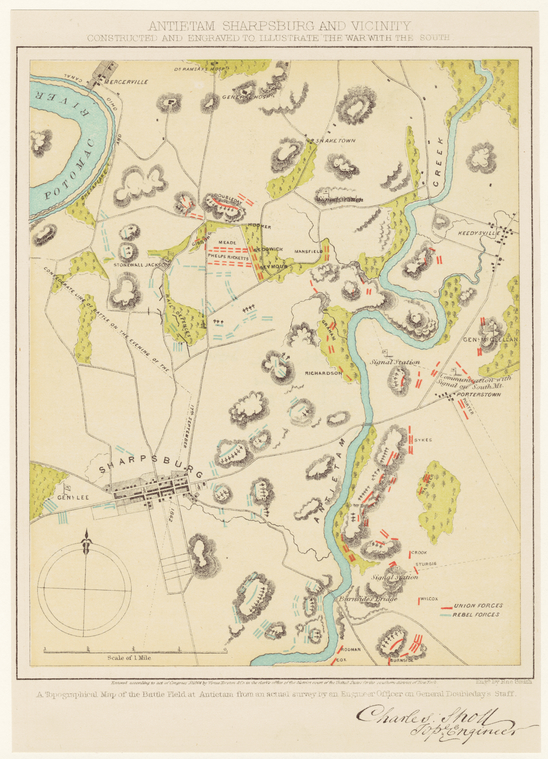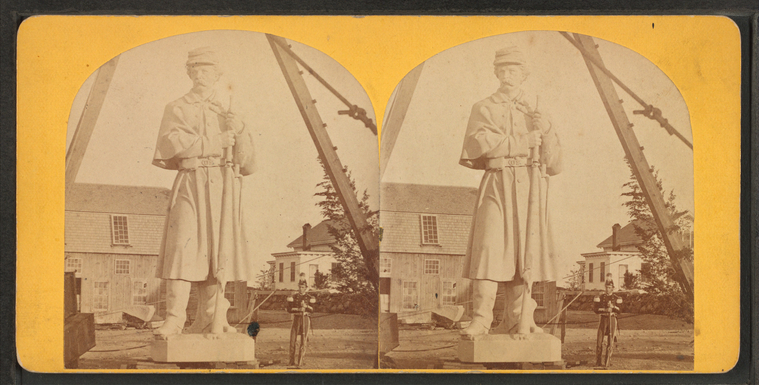Archives
United States Sanitary Commission Processing Project: After Antietam

The records of the Sanitary Commission's Statistical Bureau contain a variety of resources useful for studying battles and other military topics, among them camp inspection returns and studies of the "loss and gain" of troops following particular battles.
USSC staff inspected military camps in order to identify and report health concerns and supply shortages. Inspectors typically recorded their observations on printed questionnaires called "camp inspection returns."
 Detail of printed Camp Inspection Return, number 3, August 21, 1861
Detail of printed Camp Inspection Return, number 3, August 21, 1861
These forms were used by the USSC, especially in the early years of the war, to standardize the collection of information so that conditions could be improved by further study, recommendations and actions. Letter reports are also found among the records. Camp inspection returns have much to say about the state of individual regiments at a specific place and time.
 Detail of Form J Inspection Return, number 1, September 7, 1863Although most Statistical Bureau materials were generally identified in the United States Sanitary Commission's 1878 catalog of its records, among them the camp inspection returns, occasionally there is an encounter with material not listed there. Such is the case with post-battle studies on the effect of long forced marches and diet on the health of soldiers fighting at Bull Run and Gettysburg. Fortunately, the USSC's own publications can help identify the scope of investigation, the type of records created, and the results of their findings, allowing us make connections with the unidentified materials at hand.
Detail of Form J Inspection Return, number 1, September 7, 1863Although most Statistical Bureau materials were generally identified in the United States Sanitary Commission's 1878 catalog of its records, among them the camp inspection returns, occasionally there is an encounter with material not listed there. Such is the case with post-battle studies on the effect of long forced marches and diet on the health of soldiers fighting at Bull Run and Gettysburg. Fortunately, the USSC's own publications can help identify the scope of investigation, the type of records created, and the results of their findings, allowing us make connections with the unidentified materials at hand.
Just recently, a small leather notebook entitled "Inspection Returns, October 28, 1862," was found among unsorted Statistical Bureau materials. The journal format alone is enough to make this item unique within the realm of inspection returns, but what sets it apart is its hybrid nature, combining elements from camp inspections as well as the aforementioned battle studies.
 Front cover and interior title page, Inspection Returns, October 28, 1862
Front cover and interior title page, Inspection Returns, October 28, 1862

One of the most common observations made of the regiments in this area was their exhaustion resulting from long marches. Forces had hurried to gather in the vicinity of Sharpsburg in the days leading up to the battle, some having marched ten or more miles a day, for a week, only to arrive weakened and fatigued.
 Entry for the 13th New York Volunteers, Inspection Returns, October 28, 1862
Entry for the 13th New York Volunteers, Inspection Returns, October 28, 1862
 Entry for the 118th Pennsylvania Volunteers, Inspection Returns, October 28th, 1862Arriving at the destination was no guarantee for reprieve, however, as some regiments were sent into battle mere hours after arriving from a long march. Other regiments, such as the 118th Pennsylvania Volunteers, did not come under fire during the battle of Antietam, although they did suffer heavy casualties three days later during the reconnaissance of Shepardstown, West Virginia on September 20, 1862.
Entry for the 118th Pennsylvania Volunteers, Inspection Returns, October 28th, 1862Arriving at the destination was no guarantee for reprieve, however, as some regiments were sent into battle mere hours after arriving from a long march. Other regiments, such as the 118th Pennsylvania Volunteers, did not come under fire during the battle of Antietam, although they did suffer heavy casualties three days later during the reconnaissance of Shepardstown, West Virginia on September 20, 1862.
Amplifying these stresses and sufferings of battle were the high rates of sickness found in the camps. Camp sites were often used repeatedly by various regiments, each previous one leaving behind debris and refuse for the next. Many regiments were confronted with shortages of clothing, blankets and medical supplies. These poor conditions caused diarrhea and camp fever to become commonplace throughout the camps. The 133rd Pennsylvania Volunteers suffered greatly from both of these illnesses. Recent days of rain and frost added to the general misery.
 Entry for the 133rd Pennsylvania Volunteers, Inspection Returns, October 28, 1862This unknown inspector's journal will now be listed among related materials for future study, just one of the many battle resources in the United States Sanitary Commission records that reiterate the steady endurance required of soldiers both on and off the battlefield, and the efforts of the Sanitary Commission, working with the Army, to reduce unnecessary physical suffering.
Entry for the 133rd Pennsylvania Volunteers, Inspection Returns, October 28, 1862This unknown inspector's journal will now be listed among related materials for future study, just one of the many battle resources in the United States Sanitary Commission records that reiterate the steady endurance required of soldiers both on and off the battlefield, and the efforts of the Sanitary Commission, working with the Army, to reduce unnecessary physical suffering.

For further study:
Those interested in particular military campaigns and their impact on the home front will find resources in virtually every record group within the United States Sanitary Commission Records when the collection re-opens in 2013, among them the records of relief agents in military zones and their communications with executive offices in New York, Washington and Louisville; the women's auxiliary branches who solicited, collected and shipped supplies where needed in collaboration with USSC offices and depots; and in records documenting the USSC's publication and fund-raising work.
Benjamin Apthorp Gould explains much of the work done by the Statistical Bureau during and after the war in his Investigations in the Military and Anthropological Statistics of American Soldiers, 1869. In this text, Gould details the procedures, forms used, staff employed, and analyses attempted or completed for many of the Bureau's studies. Works by his predecessor at the Bureau, E.B. Elliott, are also useful.
Statistical Bureau camp inspection returns processed prior to this project are available on Scholarly Resources/Gale microfilm, held in several major repositories. An introduction, roll contents, and index to camp inspection records can be found on the Primary Source Media/Gale website, under "The United States Sanitary Commission Records, 1861-1866."
The New York Public Library has extensive holdings relating to the battle of Antietam and the Maryland Campaign.
For a study of the comparable experience of civilians living through the battle and its aftermath, see Kathleen A. Ernst's Too Afraid to Cry: Maryland Civilians in the Antietam Campaign, 1999.
In the holdings of the Library's Manuscripts and Archives Division, the Ezra A. Carman Papers shed light on efforts during the late 19th century to preserve the battlefield.
And finally, glimpses of the Sanitary Commission at work can be seen in the recent Ric Burns documentary for the PBS series American Experience, Death and the Civil War, based on Drew Gilpin Faust's book, This Republic of Suffering: Death and the American Civil War, 2008.
Read E-Books with SimplyE
 With your library card, it's easier than ever to choose from more than 300,000 e-books on SimplyE, The New York Public Library's free e-reader app. Gain access to digital resources for all ages, including e-books, audiobooks, databases, and more.
With your library card, it's easier than ever to choose from more than 300,000 e-books on SimplyE, The New York Public Library's free e-reader app. Gain access to digital resources for all ages, including e-books, audiobooks, databases, and more.
If you don’t have an NYPL library card, New York State residents can apply for a digital card online or through SimplyE (available on the App Store or Google Play).
Need more help? Read our guide to using SimplyE.